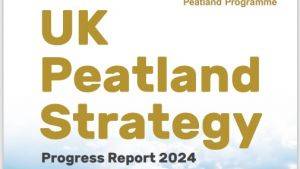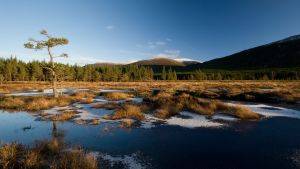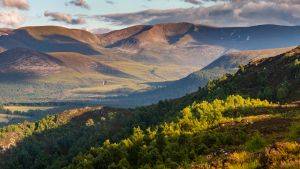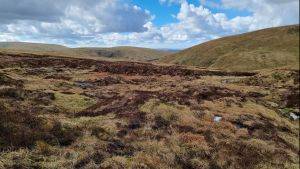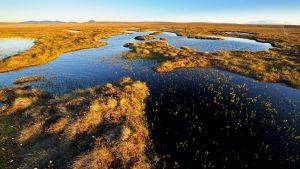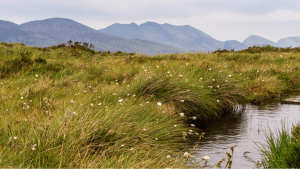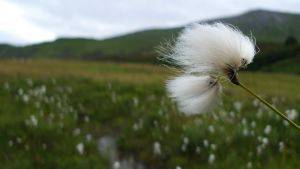RSPB Airds Moss bog enhancement 2013 - 2018
Introduction
The East Ayrshire Coalfield Environment Initiative (CEI) and partners have been working to improve bog habitats in the Coalfields since 2013 as part of the East Ayrshire Coalfields Nature Network and EcoCo LIFE projects. The CEI have delivered 430 hectares of bog enhancement work across three sites since 2013, utilising funding from the SEPA Water Environment Fund, the Heritage Lottery Fund, Cumnock and Doon Valley Minerals Trust, Peatland Action Fund and the LIFE+ financial instrument of the European Community (LIFE13 BIO/UK/000428 EcoCo LIFE). Through the EcoCo LIFE project, the CEI will continue to explore opportunities to work with land managers to enhance bog habitats. The project has commissioned a number of habitat surveys with the aims of prioritising sites for enhancement, gathering baseline habitat data and informing enhancement and management plans. The CEI have carried out enhancement work at Airds Moss, within the RSPB Reserve; Dalmellington Moss SSSI, a SWT Reserve; Tappethill Moss, a Forestry Commission Scotland plantation; Shiel Farm, at the western end of the Airds Moss SAC; and Low Moss, a raised bog near Lugar. This work has been carried out by highly skilled contractors who have used a range of techniques, including constructing peat and plastic piling dams, creating trench bunds, tree felling and scrub clearance. blog The CEI have used their expertise and taken advice from others experienced in bog restoration to use the best available methods to ensure the best possible results. We hope that the improvements at our enhancement sites will benefit bog wildlife, and will be carrying out surveys with volunteers to monitor the success of the enhancement work and to collect biological and habitat data.
Description
Airds Moss is the largest unafforested blanket bog in the South Strathclyde region and is situated within the Muirkirk Uplands between the towns of Cumnock and Muirkirk in East Ayrshire. The entire site is 8km in length and 2.5 km wide. The bog forms part of a wider area of upland moorland within the catchment of the River Ayr. Airds Moss is recognised as being of international importance for its blanket bog habitat and assemblage of breeding and wintering birds. The site has been designated as a Special Area of Conservation (SAC) under the EC Habitats Directive (92/43/EEC) for its Blanket bog habitat, which is an Annex 1 habitat and UK Biodiversity Action Plan habitat. Airds Moss is also part of the wider 26,330ha Muirkirk and North Lowther Uplands Special Protection Area (SPA) in accordance with the EC Birds Directive (79/409/EEC). The area qualifies as an SPA as it supports breeding and wintering Hen harrier Circus cyaneus, Merlin Falco columbarius, Peregrine Falco peregrinus, Short-eared owl Asio flammeus and Golden plover Pluvialis apricaria. Over 400 ha of Airds Moss is managed as a wildlife reserve by the Royal Society for the Protection of Birds (RSPB), who aim to improve the condition of the bog and adjacent floodplain habitats for the benefit of wild birds and other species. The SAC designation covers an area of approximately 1300 ha. Around 900 hectares of this is made up of a mosaic of mire communities including M18 – Erica tetralix – Sphagnum papillosum raised and blanket mire and M25 – Molinia caerulea mire. Viewed from afar, this wild landscape may appear barren, but in reality it is a unique and dynamic habitat that has enormous value to wild plants, animals and humans. The ground is undulating, tussocky and very wet underfoot in places – this is because the bog holds up to 8 metres of peat! Peat has a high water content and is saturated all year round. The peat mass (catotelm) is stored under a living layer (acrotelm) of vegetation made up of a mosaic of spongy bog mosses, cotton grasses and heathers. In the wetter areas of Airds Moss, the acrotelm exhibits surface patterns such as Sphagnum moss hummocks and lawns, and pools of open water. Pools are an excellent habitat for invertebrates such as dragonflies, and wading birds such as Golden plover feed on insects in the lawns and pools. As well as birds, Airds Moss is home to an array of fascinating plants and animals, including carnivorous sundews Drosera spp., Cranberry Vaccinium oxycoccos (pictured), White beak- sedge Rhyncospora alba, Adder Viperus berus, Brown hare Lepus europeaus, and Large Heath butterfly Tullia coenonympha (a bog specialist and UKBAP species). See the National Biodiversity Network website to explore Airds Moss biological data. Airds Moss has been modified through its historic land-use, which includes grazing, forestry, mining, and for grouse shooting. Drainage ditches have been dug across the site resulting in a drop in water levels, causing drying. This has decreased wet-loving bog plants and increased species such as Purple moorgrass Molinia caerulea and dense, tall patches of heather Calluna vulgaris. As a result the condition of SAC is classified as “unfavourable recovering”. Positive action is required to bring the bog habitat into favourable condition, and the RSPB and CEI have been working hard over several years to facilitate bog enhancement within the RSPB reserve.
Restoration Delivered
Five phases of bog enhancement work have been carried out at the reserve to date. The CEI worked in collaboration with the RSPB to deliver two phases in 2013 and 2014 as part of the CEI’s Nature Network and EcoCo LIFE (LIFE 13 BIO/UK/000428) projects and will oversee a new phase in 2015. So far, around 250 hectares of ditch blocking has been completed, with a staggering 4000+ peat dams installed across the reserve. The enhancement work is being monitored by RSPB and CEI staff and volunteers, who carry out annual vegetation surveys and bi-annual water level monitoring. Over a number of years, the RSPB will be able to evaluate the success of the enhancement work by measuring changes to the site’s hydrology and ground flora. In the future, the CEI aim to work with land managers within Airds Moss SAC and adjacent areas to bring the bog habitat into better condition through a combination of practical enhancement work and management changes.
Project Name: RSPB Airds Moss bog enhancement 2013 - 2018
Organisation / Lead partner: East Ayrshire Coalfield Environment Initiative
Location: Airds Moss Muirkirk KA18 3NQ
Approximate area covered: 440 ha
Conservation Status: Site of Special Scientific Interest (SSSI), Special Area of Conservation (SAC), Special Protection Area (SPA), Nature Reserve (NR), Natura 2000
Predominately: Lowland
Peat Habitats: Blanket bog
Project Type: Restoration, Management, Citizen science/ community engagement.
Year Project Began: 2013
Project End Date: 2018





